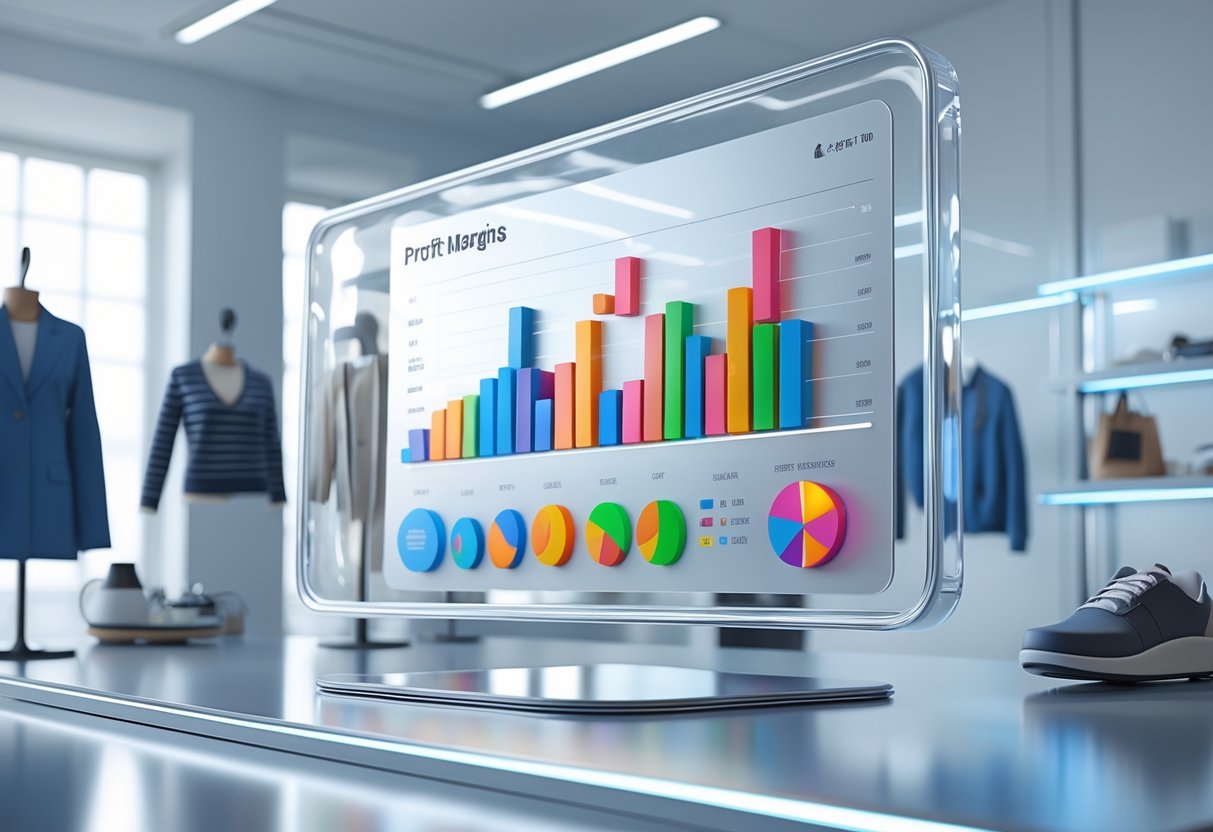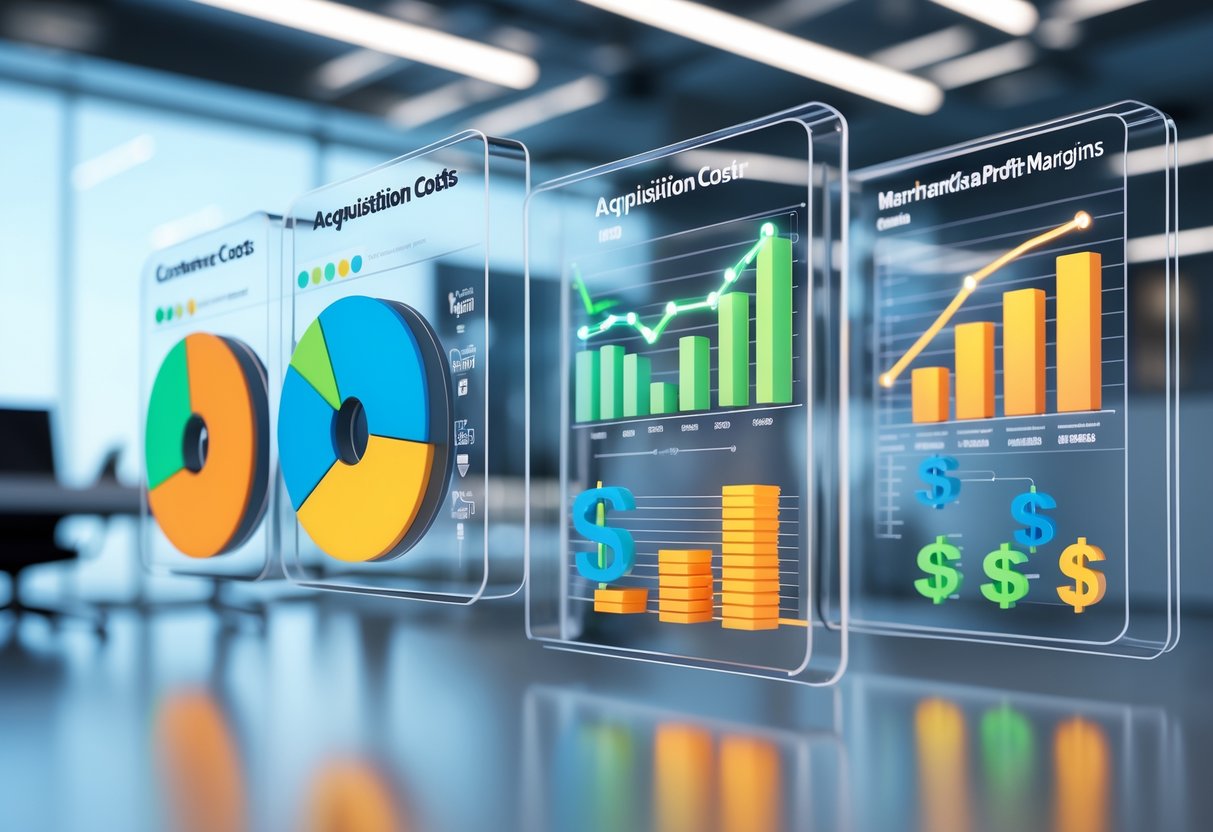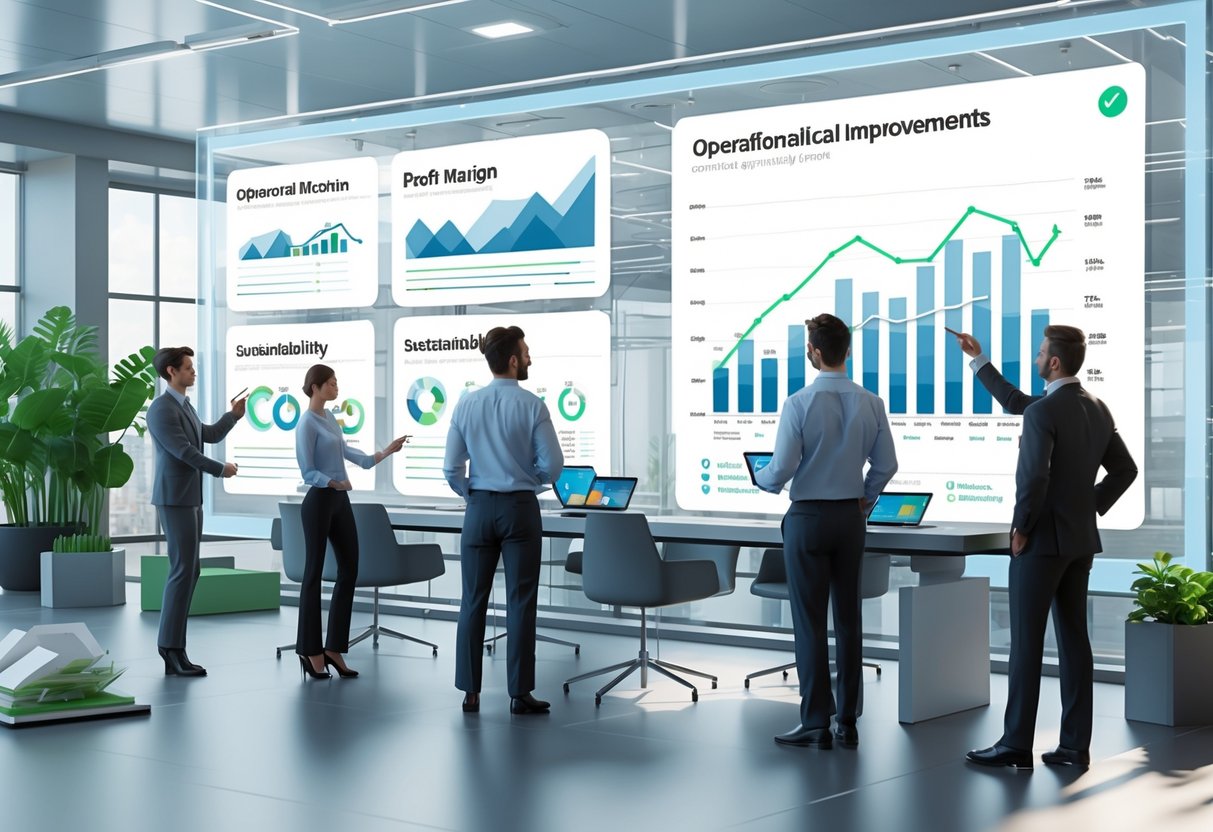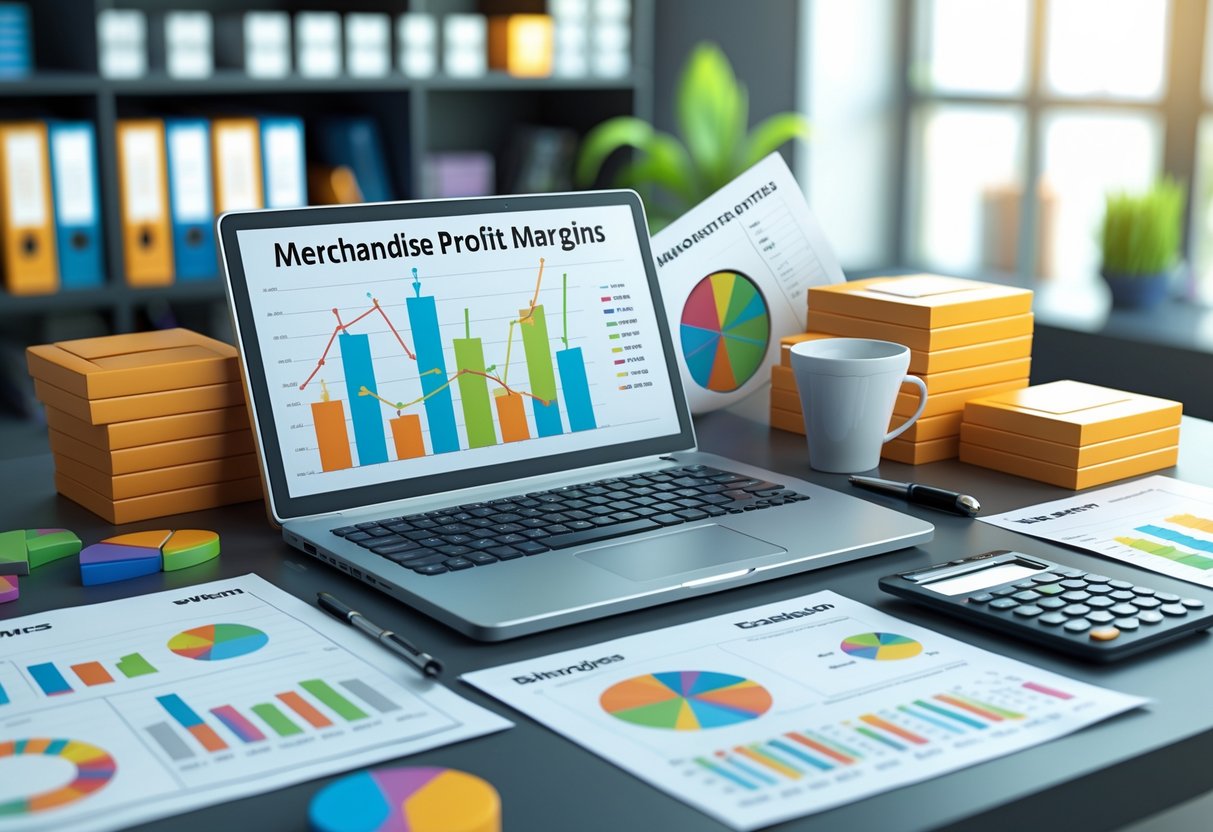Merchandise Profit Margins: Boost Retail Profitability with Smart Strategies
Updated On: November 12, 2025 by Aaron Connolly
Understanding Merchandise Profit Margins
Merchandise profit margins show how much money you actually keep from each sale after you pay for the products. These numbers help you set prices, control costs, and make smarter choices for your shop.
Definition and Importance
Profit margin tells you what percentage of your sales turns into profit after you pay your bills. It’s basically how much you keep from every pound you earn.
Gross margin looks at your direct product costs. To figure it out, subtract the cost of goods sold from your revenue, then divide that by your revenue. For example, if you sell something for £100 and it costs £60, your gross margin comes out to 40%.
Net profit margin counts all your business expenses. This gives you the full picture, including rent, wages, marketing—basically everything.
When you understand your margins, you can spot trouble early. If your numbers drop, maybe your supplier costs jumped or your prices need a second look.
Healthy margins give you breathing room, especially during slow periods or when competitors get aggressive with pricing.
Most retailers shoot for gross margins between 30% and 50%. The right target for you depends on your industry and business model.
Types of Profit Margins
You can look at profit margins in a few different ways, depending on which costs you want to focus on.
| Margin Type | What It Measures | Typical Range |
|---|---|---|
| Gross Margin | Revenue minus cost of goods | 30-50% |
| Operating Margin | Includes operating expenses | 10-20% |
| Net Profit Margin | All expenses included | 5-15% |
Gross profit margin covers just your direct product costs. It’s good for checking your pricing and your deals with suppliers.
Operating margin adds in costs like rent, wages, and utilities. This one shows if you’re running things efficiently day-to-day.
Net profit margin is what’s left after absolutely everything. If this is healthy, your business model actually works.
Key Terminology
You’ll want to know a few key terms to really get a handle on merchandise profit margins. Knowing these makes talking with suppliers or accountants way easier.
Cost of Goods Sold (COGS) is what you pay to get products ready to sell—wholesale prices, shipping, import fees. It doesn’t include wages or rent.
Revenue means your total sales before you take out any expenses. Some call it turnover or gross sales.
Mark-up and margin aren’t the same. Mark-up compares profit to your costs, while margin compares profit to your selling price. If you make £40 profit on a £60 cost, that’s a 67% mark-up, but only a 40% margin.
Variable costs go up and down with your sales, like product costs and packaging. Fixed costs stay the same, like rent and insurance.
Once you know these, you can talk more clearly about your finances and make better pricing choices.
Calculating Merchandise Margins
To really know your merchandise margins, you need to get comfortable with some basic formulas. These show you exactly how much profit each product brings in.
You’ll need good calculation tools to track both gross margins (from product costs) and net margins (which count all your business expenses).
Basic Margin Formulas
Here’s the main formula: Margin = (Selling Price – Cost of Goods Sold) ÷ Selling Price × 100. This tells you what percent of each sale is profit.
Let’s say you sell a gaming headset for £80 and it costs you £32. The margin is (£80 – £32) ÷ £80 × 100 = 60%. So, 60% of each sale goes toward covering expenses and making profit.
Markup is a little different: Markup = (Selling Price – COGS) ÷ COGS × 100. For the same headset, your markup is £48 ÷ £32 × 100 = 150%.
Knowing both helps you price better. Margin shows your profit as a percentage of the selling price, while markup shows how much you’ve bumped up the cost.
Gross and Net Margin Calculations
Gross margin looks only at direct product costs (COGS). Net margin counts all your business expenses—marketing, wages, overheads.
Gross Margin = (Revenue – COGS) ÷ Revenue × 100.
If you pull in £10,000 in sales and your COGS is £4,000, your gross margin is 60%. Add £3,000 in other expenses, and your net margin drops to 30%.
Net margin is the real deal: Net Margin = (Revenue – Total Costs) ÷ Revenue × 100. This shows if you’re actually making money after everything.
Most retailers keep gross margins between 30-50%. Net margins usually fall somewhere between 5-15%, depending on your business.
Margin Calculation Tools
Modern margin calculators make life easier and cut down on mistakes. Shopify’s profit margin calculator, retail markup calculators, and other merchandise profit tools handle tricky scenarios for you.
Spreadsheets work great for small businesses. You can set up formulas that update automatically when you change a price or cost. It’s free and gives you full control.
Look for these features in margin tools:
- Automatic updates
- Tracking for multiple products
- Export options for accounting
- Integration with your inventory system
Some retailers use systems that connect margin calculations with inventory and sales data. That way, you can see real-time profits across your whole product range.
Factors Impacting Merchandise Profit Margins
A few big things really affect how much profit you make on each product. Managing product costs, keeping shipping and operational expenses in check, and boosting sales volume all matter a lot.
Product Cost Management
Product cost is the backbone of your profit margins. Every pound you save on buying products goes straight into your margin.
When you buy in bulk, you can usually negotiate better prices. Suppliers often give volume discounts that can bump your margins by 5-15%.
Working with several suppliers gives you more power to negotiate. It also protects you if there are supply chain hiccups and someone tries to raise prices on you.
Private label products tend to bring in higher margins than branded stuff. These often cost 20-40% less to source, but you can still sell them at competitive prices.
Try out lesser-known brands that offer better wholesale terms. People don’t stick to big brands as much these days, so you might find some hidden gems with better margins.
Keep an eye on your costs regularly. Figure out which products consistently deliver strong margins, and adjust your buying strategy as needed.
Shipping and Operational Expenses
Shipping costs and how efficiently you run your shop can really eat into your profit margins. These expenses sneak up on you fast.
You can negotiate better shipping rates by combining orders or working with freight forwarders. Shipping sometimes makes up 10-20% of your product cost, so it’s worth the effort.
If your warehouse runs smoothly, you’ll turn over inventory faster and pay less for storage. Streamlining operations means you spend less handling each item.
When your staff works efficiently, you see it in your profits. Training people to work smarter cuts labor costs and usually makes customers happier, too.
Investing in inventory management tech often pays off. You’ll waste less and control stock better. If you don’t, you risk markdowns that kill your margins.
Sales Volume and Turnover
Sales volume and inventory turnover decide how quickly you turn stock into cash. Higher turnover means better cash flow and lower storage costs.
Products that sell fast often make more profit over time—even if their margins are smaller. A 20% margin item that sells monthly might beat a 40% margin product that just sits there.
Put high-margin items where people can see them. Prime shelf spots can boost those sales by 30-50%.
Try cross-merchandising and combo deals to move slow stock without slashing prices. This bumps up average order size and keeps your margins safe.
Watch for seasonal trends. If you plan inventory around busy times, you’ll avoid costly markdowns and make more money overall.
Pricing Strategies to Maximise Margins
Smart pricing can turn a struggling merchandise line into a profit machine for your esports business. If you nail competitive analysis, know what your customers care about, and time your promos right, you’ll see the results in your bottom line.
Competitive Pricing Models
With competitive pricing, you set your prices based on what similar products cost elsewhere. You’ll need to keep an eye on what other esports brands, gaming companies, and merch sellers are charging.
Start by picking out your main competitors. Check official team stores, gaming merch sites, and regular apparel brands that sell to gamers.
Make a simple system to track prices. Check your competitors’ prices for key products every month. Watch for any patterns or changes.
Where you position your price matters a lot. You might go a bit lower than competitors to attract budget shoppers. Or match the market to show you offer quality without the premium. Some brands even price higher to signal they’re top-tier.
Think about your brand’s reputation. If you’re well known, you can often charge more. If you’re new, you might need to start with lower prices to attract attention.
Don’t just copy other prices. Look at your own costs, your brand’s place in the market, and what your customers expect. The goal is to make smart, informed pricing decisions.
Value-Based Pricing
Value-based pricing means charging what your customers think your merch is worth—not just what it costs you or what competitors charge. If you get this right, your profit margins can really jump.
Find out what your customers actually care about. Ask fans which features matter most. Stuff like limited edition designs, official licenses, or premium materials often let you charge more.
Figure out the perceived value. Official jerseys usually sell for more than generic shirts because fans want that real connection with their favorite team.
Make sure your marketing spells out the value. Point out unique features, quality, or exclusive perks. Don’t expect people to just “get it” on their own.
Try out different prices. Maybe a £25 t-shirt sells 100 units a month, but a £35 one with premium fabric sells 80. You still end up making more from the pricier option.
Bundles can help too. A £50 fan pack with a shirt, badge, and sticker feels like a better deal than buying each separately for £45.
Discounting and Limited-Time Offers
Discounts can move stock and boost sales, but you have to use them wisely or you’ll hurt your margins.
Time your discounts for maximum impact. Big tournaments, team wins, or holidays are great moments for limited-time offers. Black Friday, end-of-season sales, or championship celebrations work well too.
Set your limits before you start. Know your lowest acceptable margin and stick to it. Try not to discount new or premium items more than 20-30%.
Create urgency with real deadlines. “48-hour flash sale” or “while stocks last” work better than a permanent sale section. Stick to your own rules—customers notice if you don’t.
Use tiered discounts to encourage bigger orders. “Spend £50 get 10% off, spend £75 get 15% off” helps raise your average order value while protecting margins on smaller buys.
Keep an eye on which discounts actually help your bottom line. Some promos boost sales but don’t really grow your profits, so track the results closely.
Benchmarks and Margin Expectations

Profit margins swing wildly across retail categories. Luxury brands sometimes hit 70%, but most grocery stores scrape by at around 23%. Discount stores and wholesale operations play by their own rules, using very different margin strategies than premium retailers.
Industry Averages by Category
Every retail category seems to have its own margin expectations, shaped by business models and what customers want.
Apparel and footwear usually bring in gross margins near 40%, with pre-tax profits at 6.7%. Those higher margins come from brand value and the ups and downs of seasonal shopping.
Grocery stores get squeezed harder, running on 23% gross margins and just 2.6% pre-tax profit. Fast-moving inventory and cutthroat pricing keep profits thin.
Home improvement retailers manage 33% gross margins and a stronger 11.8% pre-tax profit. The DIY crowd and project-based sales let them hold onto a bit more pricing power.
| Retail Category | Gross Margin | Pre-tax Profit Margin |
|---|---|---|
| Apparel & Footwear | 40% | 6.7% |
| Department Stores | 39% | 5.9% |
| Grocery Stores | 23% | 2.6% |
| Home Improvement | 33% | 11.8% |
| Drug Stores | 19% | 1.5% |
Electronics retailers like Best Buy try to survive on 21% gross margins. With so much competition and products going obsolete overnight, it’s tough to keep prices high.
Retail vs Wholesale Margins
Retailers usually get better margins than wholesalers, mostly because they deal directly with customers and offer extra services.
Retail margins can land anywhere from 19% up to 70%, depending on what you sell and who you sell to. Retailers bring value with things like customer support, easy returns, and shops in convenient places.
Wholesale margins typically sit between 10% and 25%. Wholesalers focus on moving big volumes and keeping operations lean, not on customer experience.
Walmart, for example, clocks in at 24% gross margins on grocery items. Their wholesale arm works at slimmer margins but makes up for it with sheer sales volume.
A few other differences stand out—think inventory holding costs, what it takes to get customers in the door, and the need to deliver great service. Retailers pour more money into store design and staff training.
Wholesalers chase logistics efficiency and fast bulk orders. They’re willing to accept lower margins if it means inventory moves quickly and customer service costs stay low.
Luxury and Discount Store Comparisons
The gap between luxury and discount retailers really shows how much positioning matters for margins.
Luxury retailers get away with higher margins by offering exclusive brands and a premium experience. Tapestry, for instance, has 70% gross margins and 15.7% pre-tax profits.
Discount stores like Dollar General focus on volume and running a tight ship. They manage 31% gross margins and 8.2% pre-tax profits, mostly through strict cost control.
Bath & Body Works sits in the premium lane with 43% gross margins and 13.8% pre-tax profits. Loyal customers let them charge more.
Off-price retailers like TJX work with 28% gross margins but still pull in 9.3% pre-tax profits. They buy up excess inventory cheap, then pass those savings on to shoppers.
Discount stores make it work by keeping operations efficient and inventory moving fast. They’re okay with slimmer margins if it means steady customer traffic and reliable sales.
Profit Margins in Ecommerce

Online retailers wrestle with margin challenges that brick-and-mortar shops rarely face. Platform fees, advertising, and shipping all chip away at profits, making margin management a bit of a juggling act.
Unique Ecommerce Considerations
Selling online changes the margin game. We have to factor in platform fees—these can jump to 15-25% on Amazon, or hover around 2.9% on Shopify.
Platform-specific costs can reshape margins entirely. Amazon FBA fees alone can hit 35% of the item price when you count storage and fulfilment. Shopify sellers often see net margins of 10-20%, while Amazon sellers make do with a tighter 5-15%.
Product categories bring their own quirks. Beauty brands often see gross margins of 50-70% thanks to fancy packaging and subscriptions. Electronics, on the other hand, barely scrape 15-25% due to stiff competition and transparent pricing.
Advertising spend is another headache. Ideally, ad costs should stay under 33% of gross revenue, but Amazon ads can easily eat up 20-33% of sales. Shopify merchants usually spend a bit less—around 15-25%.
The average order value (AOV) plays a big role. Stores with AOV above £75 can swallow shipping costs more easily, but those with lower AOV often find margins get squeezed after fulfilment.
Optimising Margins Online
Ecommerce offers margin-boosting tricks that physical retailers can’t always use. Dynamic pricing tools let us tweak prices in real time, which can bump margins up by 10-15%.
Subscription models are a game-changer. Products with subscriptions can hit gross margins of 55-65%, compared to 40-50% for single purchases. Recurring revenue gives us steady cash flow and higher customer lifetime value.
Bundle pricing lifts the average order value by 25-40%. When shoppers grab multiple items at once, we cut per-order costs and keep margins healthy on the total sale.
Private labelling is another big win. Private label brands on Amazon can reach 50-60% gross margins, while third-party sellers settle for 25-35%. Controlling sourcing and pricing gives us a real edge.
We also try to negotiate better shipping rates with regional carriers—sometimes saving 15-20% over standard options. Free shipping thresholds (say, £75 or more) encourage bigger baskets and protect profits.
Challenges Faced by Online Retailers
Return rates can hit margins hard. Apparel brands, for example, see returns of 25-40%, which can slice net profits by 8-12%. It’s crucial to bake these costs into pricing right from the start.
Inventory management gets tricky online. We try to keep total inventory costs within 15-25% of gross revenue, but if we mess up planning, dead stock can swallow more than 20% of warehouse space. Hitting 8+ inventory turns per year keeps margins in the safe zone.
Customer acquisition costs just keep climbing. We need a minimum ROAS of 2.8:1 to break even, but real growth usually means hitting 3.5:1 or higher. If our mobile site isn’t up to scratch, conversion costs can spike by 28%.
Cash flow timing is another stress point. We often pay for inventory and ads weeks before sales revenue comes in. Keeping 3-6 months of expenses in reserve helps us stay afloat when cash is tight.
Multi-platform complexity makes margin tracking a headache. Every platform has its own fees, ad costs, and customer quirks. We set separate margin targets for each channel to keep the whole operation profitable.
Private Label and Product Development Approaches

Private label products let retailers take charge of their merchandise profit margins through smart product development and sourcing. Good market research helps us pick winners, while better sourcing can slash costs.
Benefits of Private Label Products
Higher profit margins top the list of private label perks. We often cut manufacturing costs by 40-50% compared to big brands.
We control pricing strategies completely. Where branded products come with fixed wholesale costs, private label lets us tweak margins based on the market and what customers want.
Brand differentiation gets a lot easier. Customers can’t find our exact products anywhere else, so there’s less price comparison.
We also keep quality control in our hands. We can set our own standards for materials, manufacturing, and packaging to fit our brand and customer expectations.
The customer loyalty factor shouldn’t be underestimated. Studies show 90% of people who buy private label keep buying even if national brands go on sale—they just feel they’re getting better value and quality.
Product Sourcing and Cost Reduction
Manufacturer research means we dig into reviews, pricing, and processes before choosing suppliers. It’s not glamorous, but it saves headaches later.
Trade directories, online marketplaces, and industry events all help us find manufacturers. Sometimes, a tip from another retailer is worth more than any directory listing.
Sample evaluation is key. We always ask for samples and detailed quotes before going big on orders, just to make sure everything’s up to scratch.
Negotiating minimum order quantities can make or break our first investment. Smaller minimums mean we can test demand without drowning in inventory.
Partnership terms need to spell out payment, delivery, quality control, and warranty. Clear contracts keep everyone honest and set expectations.
Quality assurance systems during production help us stay on top of things. Regular checks during manufacturing stop bad products from reaching customers.
Market Research for Development
Trend analysis helps us spot profitable product ideas before everyone else jumps in. We watch what customers are doing, especially when the economy’s shaky.
Right now, trends like premiumisation—people wanting better quality for a fair price—and localisation are big. Folks love regionally-sourced ingredients and materials.
Gap identification is about finding market segments that competitors miss. Tools like AMZScout help us see what’s missing from the market.
Profitability assessment is a must. We crunch numbers on manufacturing costs, selling prices, and projected margins before we commit.
Scalability evaluation checks if a product makes sense long-term. We look at seasonal swings, related products, and whether we can expand before locking in our choices.
We run surveys and focus groups to see what customers actually want. There’s no point developing a product if nobody cares.
Inventory Management and Turnover

Smart inventory management has a direct impact on your merchandise profit margins. It all comes down to how fast you move stock and how much you make per sale. The Turn Earn Index (TEI) multiplies inventory turnover by your gross margin percentage to show where you really stand.
Inventory Turnover Metrics
We figure out inventory turnover by dividing cost of goods sold by average inventory value. This tells us how many times we sell and restock each year.
Key metrics to keep an eye on:
- Inventory turns per year (shoot for 4-12, depending on what you sell)
- Days sales outstanding (lower is better)
- Turn Earn Index (turnover × gross margin %)
Let’s say a retailer sells 300 gaming headsets every four months from an average of 300 in stock—they’re turning inventory 3 times a year. Higher turns mean better cash flow, but you’ve got to juggle that with keeping margins healthy.
The Turn Earn Index helps us compare products. If Product A gets 6 turns at a 20% margin (TEI = 120%) and Product B gets 3 turns at 45% (TEI = 135%), Product B actually delivers better returns, even if it moves slower.
We always check how we stack up against the industry. Electronics usually hit 8-10 turns a year, while luxury goods might only manage 2-4, but with fatter margins.
Efficient Inventory Practices
We use demand forecasting and smart purchasing to keep inventory in check. The best forecasting tools help us predict sales and avoid over-ordering.
Some must-do practices:
- Review stock regularly—weekly for fast sellers, monthly for slow movers
- Use ABC analysis to focus on high-value items
- Work closely with suppliers
- Try just-in-time ordering when possible
Competitive pricing keeps inventory moving without killing profits. We watch what competitors charge and adjust our markups when needed.
Storage and handling costs can eat away at margins, so we try to minimise how long inventory sits. Fast turnover means lower warehouse bills and less risk of stuff going out of date.
Investing in inventory management tech pays off. Real-time tracking helps us avoid mistakes and make data-driven decisions about reordering and pricing.
Avoiding Stockouts and Overstock
Stockouts annoy customers and kill sales. Overstock ties up cash and racks up storage bills. We keep both risks in check with careful monitoring.
Red flags include:
- Stockout rates over 5%
- Inventory sitting for more than 90 days
- Seasonal products close to expiry
We hold safety stock for essentials but avoid piling up slow sellers. Regular analysis helps us spot which products need a push or a price cut before they turn into dead stock.
Seasonal planning is a lifesaver. We order extra before busy periods and scale back after. Holiday items need aggressive discounts after the season to avoid January leftovers.
Keeping sales, purchasing, and warehouse teams talking is crucial. Weekly inventory meetings help us spot problems early and tweak orders before issues get out of hand.
Enhancing Margins Through Sales Tactics

Smart sales tactics can give your merchandise profit margins a real lift—without raising prices. The trick is selling more per customer and turning shoppers into repeat buyers.
Product Bundling for Profit
Product bundling brings related items together at a discount. You can boost total sales while still keeping healthy margins on the combined purchase.
Bundle high-margin items with popular products. Pair slow-moving stock with bestsellers to clear out inventory. For example, try bundling a gaming headset with a new console release.
Create themed bundles that actually solve customer problems. Gaming bundles might look like:
- Controller + charging station + protective case
- New game + strategy guide + branded merchandise
- Console + extra controller + popular game titles
Price bundles to encourage upgrades. Set bundle prices about 10-15% below the cost of buying items individually. Customers feel they’re getting a deal, and you still protect your margins on those pricier items.
Jump on seasonal opportunities for bundling. Back-to-school bundles or holiday gift sets naturally encourage bigger purchases during busy shopping periods.
Loyalty and Retention Strategies
Loyal customers spend about 67% more than new ones. Building strong retention programs directly impacts long-term profit through repeat sales.
Design loyalty programs around how often people buy, not just how much they spend. Points-based systems work especially well for gaming merchandise.
Offer exclusive early access to new releases. Gaming fans will pay a premium for limited editions or pre-orders if they feel like VIPs.
Create membership tiers with growing benefits. Basic members get standard discounts. Premium members might receive free shipping, exclusive products, or birthday bonuses.
Send personalized recommendations based on what people bought before. If someone picked up a fighting game controller, maybe they’d love an arcade stick or custom button sets.
Track customer lifetime value to spot your most profitable fans. Focus your retention efforts on medium-to-high value customers who come back often.
Increasing Average Order Value
Raising average order value helps profit margins without searching for new customers. Small bumps here add up fast.
Use smart product placement near checkout. Put low-cost, high-margin accessories like cables, cases, or cleaning kits front and center. Many customers grab these on impulse.
Set minimum purchase thresholds for free shipping. If your average order is £45, offer free shipping at £50. People will often toss in an extra item to qualify.
Try “customers also bought” suggestions. Show related products on product pages and during checkout. Someone buying a gaming chair might need desk accessories or cable organizers.
Create urgency with limited-time offers. “Add a second controller for 20% off” nudges people to buy more when they feel they’re getting a deal.
Offer volume discounts on consumables. Gaming gear like batteries, cleaning supplies, or replacement parts sell well in multi-packs with better margins than singles.
Train staff to naturally suggest relevant add-ons. If someone buys a new headset, mention compatible foam replacements or a carrying case.
Analysing and Monitoring Margin Performance

Tracking your merchandise profit margins means reviewing data consistently and using the right metrics to spot trends early. We need systems that show us where money flows and warning signs before they turn into big problems.
Using Data Analytics
Real-time tracking gives the clearest view of margin health. Modern point-of-sale systems capture every transaction as it happens. This data reveals which products perform well and which ones drag down profits.
We break down performance by a few key areas:
- Product categories (electronics, clothing, accessories)
- Time periods (daily, weekly, monthly)
- Customer segments (retail, wholesale)
- Geographic locations (different stores or regions)
Inventory management systems connect straight to margin analysis. When we track stock levels with sales data, patterns pop up fast. Fast-moving items with good margins deserve more shelf space.
Supplier invoice tracking shows cost changes before they hit profits. We upload invoices to spreadsheets or accounting software. This way, we get alerts when suppliers raise prices unexpectedly.
Many retailers use platforms like Shopify or Amazon seller tools for built-in margin reports. These show gross profit percentages and highlight problem areas right away.
Key Profitability Metrics
Gross margin is our foundation. We work it out as (Revenue – Cost of Goods Sold) ÷ Revenue × 100. If a bakery sells £10,000 in bread with £6,000 in ingredient costs, that’s a 40% gross margin.
Operating margin adds in all business expenses like rent and salaries. The formula is (Operating Income ÷ Revenue) × 100. This tells us if the core business actually makes money beyond just selling products.
Net profit margin covers every expense, including taxes and interest payments. We calculate it as (Net Profit ÷ Revenue) × 100. This shows true business profitability after all costs.
| Margin Type | Formula | What It Shows |
|---|---|---|
| Gross | (Revenue – COGS) ÷ Revenue × 100 | Product pricing efficiency |
| Operating | Operating Income ÷ Revenue × 100 | Core business profitability |
| Net | Net Profit ÷ Revenue × 100 | Overall financial health |
Contribution margin helps with product decisions. We subtract only variable costs from revenue. Products with higher contribution margins help cover fixed costs like rent faster.
Break-Even Analysis Best Practices
Break-even calculations tell us exactly how many units we need to sell to cover all costs. The formula is Fixed Costs ÷ (Selling Price per Unit – Variable Cost per Unit).
A coffee shop with £30,000 in monthly fixed costs uses this analysis. If each cup sells for £3 and costs £1 to make, they need to sell 15,000 cups every month just to break even.
We check break-even points monthly since costs change often. Rent increases or supplier price jumps shift our break-even line right away.
Scenario planning lets us prepare for different situations. We figure out break-even points for different price levels and cost structures. This gives us options when margins get squeezed.
Warning signs show up when actual sales fall below break-even. We track this weekly to catch issues fast. If we miss break-even targets for two weeks running, it’s time for immediate action.
Smart retailers calculate break-even for each product line too. This way, we see which products actually drive profit versus those that just bring in revenue.
Customer Acquisition Costs and Segmentation

Smart esports merchandise retailers know not all customers cost the same to acquire, and some bring in much better profit margins. Understanding these costs helps us target the right customer groups and maximize returns on marketing spend.
Understanding Acquisition Costs
Customer acquisition cost shows exactly what we spend to win each new customer. This covers advertising, promotional discounts, affiliate commissions, and marketing staff time.
The formula’s simple: total marketing costs divided by new customers gained. If we spend £1,000 on Facebook ads and get 50 new customers, our acquisition cost is £20 each.
Different marketing channels vary a lot in cost. Social media ads might run £15 per customer, while influencer partnerships could be £40. Email campaigns often come in cheapest at around £5 per customer.
Tracking costs by product category matters too. Gaming headsets might cost £25 to sell through ads, but rare collectibles could justify £80 in acquisition costs because of higher margins.
We also need to factor in hidden costs like customer service, payment processing, and handling returns. These extras can add 20-30% to the basic advertising spend.
Segmenting Customers for Margin Growth
Customer segments based on profit potential help us focus marketing where it matters most. High-value collectors buying limited edition items need different treatment than casual buyers after basic accessories.
Premium customers usually spend £200+ per order and shop often. They respond to exclusive previews and personalized recommendations, even if acquisition costs hit £50-80.
Budget-minded customers want clear discounts and practical items under £50. We target these folks with cost-effective channels like email and organic social media.
Repeat customers cost way less to serve than new ones. Studies show returning customers convert 60-70% better than first-time visitors, so retention campaigns really pay off.
Geographic segments show different patterns too. Urban customers often accept higher prices for faster delivery, while rural buyers go for bulk discounts to offset shipping.
Balancing CAC and Customer Value
Smart retailers match what they spend on acquisition to the customer’s lifetime value. Spending £40 to get a customer worth £300 over two years? That’s a win.
We figure this out by tracking average order values, how often people buy, and retention rates for each segment. A customer buying twice a year at £75 per order for three years brings in £450.
The golden ratio says acquisition costs should stay below 25% of first-year customer value. This leaves room for product costs, operations, and profit, while still building sustainable growth.
Regular testing helps keep this balance right. We might spend more on premium customers during peak seasons when conversion rates spike, then pull back during quieter times.
Just don’t fall into the trap of chasing ultra-low acquisition costs if those customers never return or only buy low-margin products.
Operational Improvements for Sustainable Margins

Smart operational changes can boost profit margins by 15-25% in the first year. The key is streamlining processes, adopting the right tech, and building systems that grow with your business.
Boosting Operational Efficiency
Operational efficiency in retail starts with cutting waste everywhere. The biggest wins come from inventory management, staff productivity, and supply chain tweaks.
Inventory turnover affects cash flow and storage costs directly. Fast sellers need prime shelf space, while slow movers call for clearance strategies. Poor stock rotation alone can eat up 2-3% of your margins.
Staff scheduling by traffic patterns trims labor costs fast. Busy hours need full teams, but slow times only need a skeleton crew. Modern point-of-sale systems track these patterns for you.
Supply chain improvements pay off quickly:
- Negotiate better payment terms with suppliers
- Consolidate orders to save on shipping
- Switch to local suppliers for speed
- Use just-in-time ordering for perishables
Energy costs quietly drain profits. LED lighting, programmable thermostats, and motion sensors can cut utility bills by 20-40%. These upgrades usually pay for themselves within 18 months.
Leveraging Technology in Retail
Cloud-based retail tech changes how we track costs and spot profit leaks. The right systems give real-time visibility into every part of operations.
Automated pricing tools adjust prices based on demand, competition, and inventory. Dynamic pricing can boost margins by 2-5% if you roll it out gradually.
Modern inventory systems prevent both stockouts and overstock. They track sales speed, predict demand, and reorder popular items automatically. That cuts carrying costs and maximizes turnover.
| Technology Solution | Initial Cost | Margin Improvement | Payback Period |
|---|---|---|---|
| POS System | £2,000-£5,000 | 3-5% | 12-18 months |
| Inventory Software | £50-£200/month | 5-8% | 6-12 months |
| Dynamic Pricing | £100-£500/month | 2-5% | 3-6 months |
Customer data analytics reveal what people actually buy and like. This helps with targeted promos, smarter product placement, and personalized marketing that drives bigger purchases.
Heads up: Don’t splurge on pricey enterprise software before testing simpler options. Many small retailers do just fine with basic cloud tools under £100 a month.
Scaling for Profitability
Profitable scaling means building systems that handle growth without costs ballooning. We focus on processes that get more efficient as you grow.
Standardized procedures cut training time and reduce mistakes. Document everything from opening routines to customer service scripts. New staff get up to speed faster, and you keep customer experience consistent.
Bulk buying power grows as you scale. Set minimum order quantities to unlock better wholesale prices. Team up with other retailers for group buying when you can.
Tech investments should anticipate future needs. Pick systems that handle 3-5 times your current transaction volume. Switching later often costs more than starting with scalable solutions.
Multi-location expansion spreads fixed costs across more revenue. Rent, insurance, and management overhead shrink as a percentage of sales. But each new location needs consistent systems and routines.
Automated reporting tracks performance across all locations. Weekly margin analysis by category, store, and time period shows trends fast. This helps you react quickly to problems or opportunities.
Quick win: Automate one process each month. Payroll, inventory ordering, or customer emails are good places to start for most retailers.
Frequently Asked Questions

Understanding profit margins is crucial for any merchandise business, whether you’re selling t-shirts, mugs, or custom products. Here are the most common questions retailers ask about maximising their profits.
What factors determine a good profit margin for retail products?
Your product type makes the biggest difference in what kind of margin you can actually get. If you’re selling custom or niche items, you can often pull off higher margins—sometimes 60-80%. That’s mostly because customers have a tough time finding the same thing elsewhere.
Market competition really shapes your pricing power. If you’re selling stuff that’s everywhere, you’ll probably have to settle for lower margins, maybe 30-50%, just to keep up.
Production costs hit your margins directly. When you keep manufacturing costs low, negotiate well with suppliers, or buy in bulk, you’ll see healthier margins.
Brand strength counts for a lot. Big-name brands can usually charge more, but if you’re new, you might need to start with slimmer margins until people know you.
How can one effectively calculate the profit margin on merchandise?
Use a simple formula: subtract your cost of goods sold from your selling price, then divide by the selling price. Multiply by 100, and there’s your margin percentage.
Say you sell a t-shirt for £20 and it costs £8 to make. That’s (£20 – £8) ÷ £20 = 60%.
Remember to count every cost. That includes production, shipping, packaging, and any customisation.
A basic spreadsheet can help you track margins for each product. You’ll spot your most profitable items and know what to push harder.
What are typical profit margin percentages in the fashion industry?
Most clothing businesses see margins around 10% if things are average. If you’re hitting 20%, you’re doing pretty well in fashion.
Custom t-shirts and similar merch can get much higher margins—sometimes 40-60%.
Accessories and small items like mugs, phone cases, or stickers? Those usually deliver even better margins, often 50-70%.
Print-on-demand services usually mean lower margins because the per-unit cost is higher. Still, you skip the risk and upfront costs of holding inventory.
How do seasonal trends affect product profit margins?
During busy seasons like holidays, you can usually charge more since everyone’s buying. Some retailers see margins jump 40-50% around Christmas.
Seasonal gear—summer stuff or winter clothes—often gets premium prices when people need them most. That can mean a 25-35% margin boost.
If you’re stuck with off-season stock, margins can take a hit. Heavy discounts on unsold items eat into profits.
If you plan ahead, you can stock high-margin products right when demand peaks. Looking back at your sales data helps you nail the timing.
Can you suggest ways to improve profit margins without increasing prices?
Try negotiating better deals with suppliers or switching to cheaper materials. Even small savings can really add up.
Buying in bulk usually gets you a better price per item. Of course, you’ll need more cash upfront, but it’s often worth it.
Push your higher-margin products in your marketing. It’s better to sell what makes you more money—not just what sells fast.
Bundling products can lift your average order value while keeping prices appealing. People love a good deal, even if the individual items cost more.
Streamlining operations and tightening up inventory management can cut overhead. Sometimes, just getting more efficient can boost your margins by 20-30%.
What is the impact of bulk purchasing on a product’s profit margin?
When you buy in bulk, you usually shave off 15-40% from your per-unit costs. Of course, the exact savings depend a lot on the product and your supplier.
That lower cost per item? It bumps up your profit margins pretty noticeably.
But you’ll need to put in more money upfront for those bigger orders. In most cases, the better margins make it worth the risk—still, it’s smart to crunch the numbers and know your break-even point first.
Don’t forget about storage costs. Warehousing, insurance, and even the risk of some stuff going to waste can eat into your savings.
Ordering in bulk also lets you negotiate with suppliers a bit more aggressively. Sometimes you can snag better payment terms or extra discounts if you keep those big orders coming.
Just watch out for over-ordering, especially with seasonal or trendy products. Bulk buying really shines with steady sellers that won’t go out of style anytime soon.

